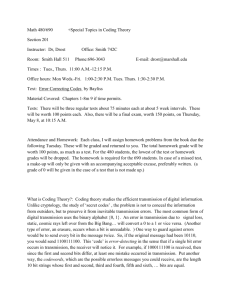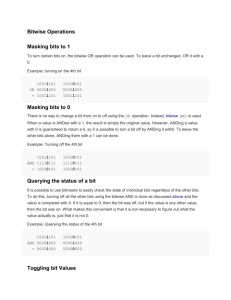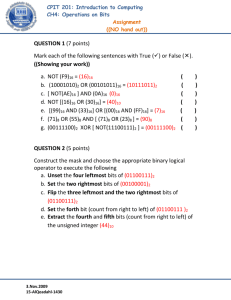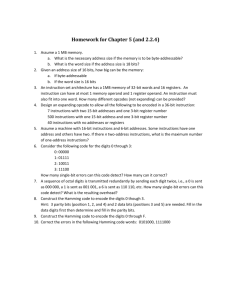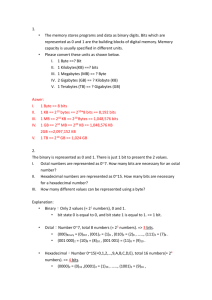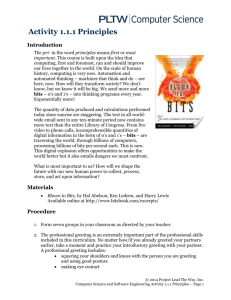Bits: a Bayesian Intelligent Tutoring System for Computer
advertisement
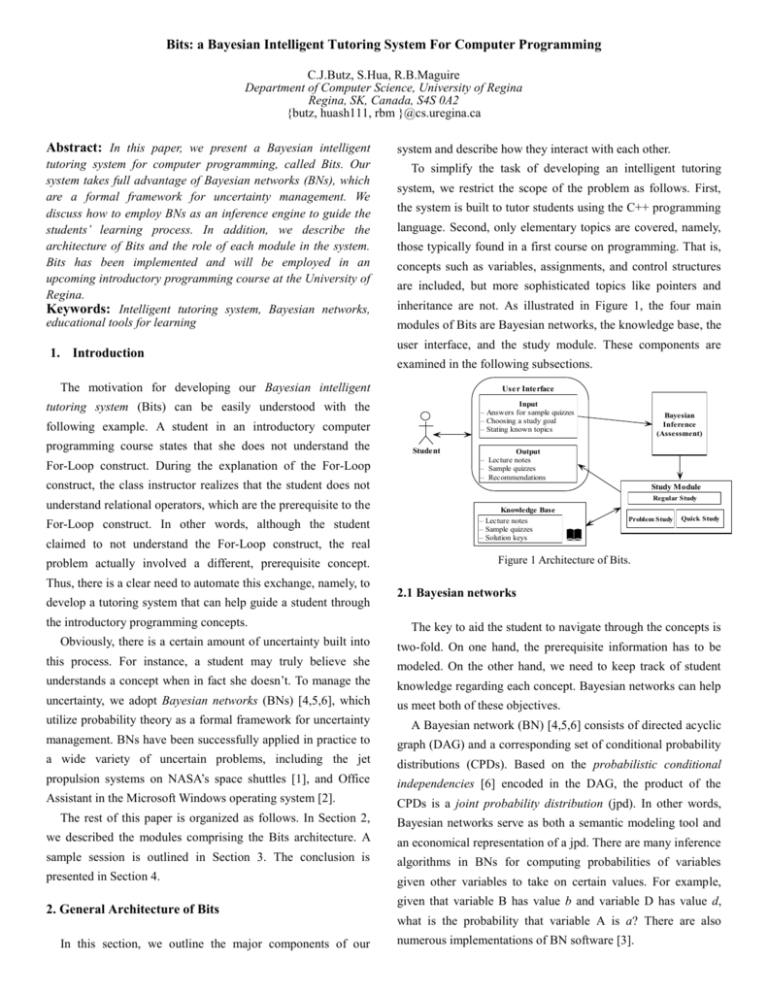
Bits: a Bayesian Intelligent Tutoring System For Computer Programming
C.J.Butz, S.Hua, R.B.Maguire
Department of Computer Science, University of Regina
Regina, SK, Canada, S4S 0A2
{butz, huash111, rbm }@cs.uregina.ca
Abstract: In this paper, we present a Bayesian intelligent
tutoring system for computer programming, called Bits. Our
system takes full advantage of Bayesian networks (BNs), which
are a formal framework for uncertainty management. We
discuss how to employ BNs as an inference engine to guide the
students’ learning process. In addition, we describe the
architecture of Bits and the role of each module in the system.
Bits has been implemented and will be employed in an
upcoming introductory programming course at the University of
Regina.
Keywords: Intelligent tutoring system, Bayesian networks,
educational tools for learning
1. Introduction
system and describe how they interact with each other.
To simplify the task of developing an intelligent tutoring
system, we restrict the scope of the problem as follows. First,
the system is built to tutor students using the C++ programming
language. Second, only elementary topics are covered, namely,
those typically found in a first course on programming. That is,
concepts such as variables, assignments, and control structures
are included, but more sophisticated topics like pointers and
inheritance are not. As illustrated in Figure 1, the four main
modules of Bits are Bayesian networks, the knowledge base, the
user interface, and the study module. These components are
examined in the following subsections.
The motivation for developing our Bayesian intelligent
User Interface
Input
– Answers for sample quizzes
– Choosing a study goal
– Stating known topics
tutoring system (Bits) can be easily understood with the
following example. A student in an introductory computer
programming course states that she does not understand the
For-Loop construct. During the explanation of the For-Loop
construct, the class instructor realizes that the student does not
understand relational operators, which are the prerequisite to the
For-Loop construct. In other words, although the student
claimed to not understand the For-Loop construct, the real
problem actually involved a different, prerequisite concept.
Thus, there is a clear need to automate this exchange, namely, to
develop a tutoring system that can help guide a student through
the introductory programming concepts.
Student
Bayesian
Inference
(Assessment)
Output
– Lecture notes
– Sample quizzes
– Recommendations
Study Module
Regular Study
Knowledge Base
– Lecture notes
– Sample quizzes
– Solution keys
Problem Study
Quick Study
Figure 1 Architecture of Bits.
2.1 Bayesian networks
The key to aid the student to navigate through the concepts is
Obviously, there is a certain amount of uncertainty built into
two-fold. On one hand, the prerequisite information has to be
this process. For instance, a student may truly believe she
modeled. On the other hand, we need to keep track of student
understands a concept when in fact she doesn’t. To manage the
knowledge regarding each concept. Bayesian networks can help
uncertainty, we adopt Bayesian networks (BNs) [4,5,6], which
us meet both of these objectives.
utilize probability theory as a formal framework for uncertainty
A Bayesian network (BN) [4,5,6] consists of directed acyclic
management. BNs have been successfully applied in practice to
graph (DAG) and a corresponding set of conditional probability
a wide variety of uncertain problems, including the jet
distributions (CPDs). Based on the probabilistic conditional
propulsion systems on NASA’s space shuttles [1], and Office
independencies [6] encoded in the DAG, the product of the
Assistant in the Microsoft Windows operating system [2].
CPDs is a joint probability distribution (jpd). In other words,
The rest of this paper is organized as follows. In Section 2,
Bayesian networks serve as both a semantic modeling tool and
we described the modules comprising the Bits architecture. A
an economical representation of a jpd. There are many inference
sample session is outlined in Section 3. The conclusion is
algorithms in BNs for computing probabilities of variables
presented in Section 4.
given other variables to take on certain values. For example,
2. General Architecture of Bits
In this section, we outline the major components of our
given that variable B has value b and variable D has value d,
what is the probability that variable A is a? There are also
numerous implementations of BN software [3].
For our purposes, we identified a set of concepts that are
probability of each concept being known, namely, p(ai= known),
taught in CS110 (the first computer programming course at the
can then be determined. Moreover, we can also compute
University of Regina). Each concept is represented by a node in
p(ai=known, Pi=known), i.e., the probability that the student
the graph. We add a directed edge from one concept (node) to
correctly answers both the concept ai and the prerequisite
another, if knowledge of the former is a prerequisite for
concepts Pi. From p(ai=known, Pi=known),
understanding the latter. Thus, the DAG can be constructed
p(ai=known | Pi=known) can be obtained. Thereby, we can
manually with the aid of the course textbook. For example,
calculate every CPD for the entire Bayesian network.
the desired CPD
consider one instance of the For-Loop construct in C++ such as
2.2 Knowledge Base
for (i=1; i<=10; i++);
To understand the For-Loop construct, one must first
understand the concepts of Variable assignment, Relational
operators,
and
Increment
(decrement)
operators.
These
relationships can be modeled as depicted in Figure 2. Naturally,
Figure 2 depicts a small portion of the entire DAG implemented
in Bits.
The knowledge base contains the class lecture notes in the
form of web pages, a repository of sample tests, which are in the
form of interactive flash multimedia files, and solution keys.
Both the lecture notes and quizzes are organized by concept.
This allows the concepts to be indexed and retrieved efficiently.
The class lecture notes are displayed while the user is
Variable Assignment
Increment/Decrement
operators
Relational Operators
learning a new concept. On the contrary, a sample quiz is
displayed when Bits is trying to determine whether or not a
student has understood a particular concept.
2.3 User Interface Module
For Loop
A student interacts with Bits through the user interface
Figure 2 Sub-DAG for the For-Loop construct.
The next task in the construction of the BN is to specify a
module. This interaction is partitioned into two sub-modules; an
CPD for each node given its parents. For variable ai with parent
input module for input from a student to Bits, and an output
set Pi, a CPD p(ai|Pi) has the property that for each
module for output from Bits to a student.
configuration (instantiation) of the variables in Pi, the sum of the
The output module displays the class lecture notes through a
probabilities of ai is 1.0. In Figure 2, the parent set of the
web browser. It uses dialog boxes to display quizzes and offer
For-Loop node is {Variable assignment, Relational operators,
pedagogical suggestions.
Increment /decrement operators}. The corresponding CPD
p ( For Loop | Assignment , Relational Operators, Incre / Decrement operators )
The primary goal of the input module is to update the BN
based on evidence collected from the student. There are two
ways in which the student can enter information into Bits:
is shown in Figure 3.
(a) Direct input,
Parent Nodes
Variable
Assignment
Relational
Operators
known
known
not known
known
not known
not known
For Loop
Incre/Decrement
operators
known
not known
(b) Select multiple-choice answer in sample quiz.
known
0.75
0.25
For (a), after the student has finished reading the displayed
not known
0.39
0.61
lecture notes, Bits will ask the student to select one of the three
known
0.50
0.50
not known
0.22
0.78
options: (i) I understand this concept, (ii) I don’t understand this
known
0.50
0.50
not known
0.29
0.71
known
0.40
0.60
If either of the first two choices is selected, then the BN can
not known
0.15
0.85
be immediately updated. On the other hand, the last choice leads
Figure 3 The CPD corresponding to the For-Loop node in Figure 2.
concept, or (iii) I am not sure (quiz me).
to the second type of input.
All CPDs for the DAG were obtained from the results of
In case (b) when the student is not sure about a concept, Bits
previous CS110 final exams. We first identified the concept
will retrieve the appropriate quiz from the knowledge base and
being tested for each question. If the student answered the
present it to the student. The question(s) are multiple choice.
question correctly, then we considered the concept known.
After the student inputs the answer, Bits compares the answer
Similarly, if the student answered the question incorrectly, then
with the solution key. Bits then gives the student immediate
we considered the concept unknown (not known). The
feedback and updates the BN accordingly.
2.4 Study Module
(a), then the Navigation Menu is refreshed. We discuss (b) next.
The study module guides the student through the class
concepts using three sub-modules called Regular Study,
Problem Study, and Quick Study.
2.4.1 Regular Study
We keep track of the student’s knowledge of a concept using
three categories; (i) known, (ii) ready to learn, and (iii) not
ready to learn. A concept is considered known if the BN
indicates a probability greater or equal to 0.70. A concept is
marked ready to learn if the probability is less than 0.70 and all
of the parent concepts are known. Finally, a concept is labeled
not ready to learn, if at least one parent concept is not known.
When Bits is first started, the concepts are labeled based on
the initial probabilities obtained from the BN. Traffic signs are
employed as follows: yellow (known), green (ready to learn),
and red (not ready to learn), as illustrated in Figure 4. A student
can select a green topic in Figure 4. The lecture notes on the
chosen topic are then displayed. For example, if the student
chooses the green concept “Floating-point numbers” in Figure 4,
Bits displays the lecture notes in Figure 5.
Figure 5 Lecture notes for concept “Floating-point-numbers.”
2.4.2 Problem Study
This module is useful when a student indicates that a concept
is not understood. One possibility is to simply ask the student to
read the lecture notes again. However, Bits is designed to show
the student both the concept to be learned and the prerequisite
concepts of this topic, namely, the parents of the concept in the
BN.
The student is given the flexibility to revisit the prerequisite
concepts to confirm that they are indeed understood. The
rationale is that a student may believe that a prerequisite
concept is understood when in fact it is not.
2.4.3 Quick Study
A student may want to learn a particular topic without
learning every single topic. For example, a student may want to
learn “File I/O” for an impending exam or assignment deadline.
The student would then like to learn the minimum set of
concepts in order to understand the chosen concept.
Figure 4 Navigation Menu: green means “ready to learn,” yellow
means “already known,” and red means “not ready to learn.”
After reading the lecture notes, the student selects one of the
following three choices:
(a) I understand this concept;
(b) I don’t understand this concept;
(c) I am not sure if I understand this concept,
as shown in the bottom right corner of Figure 5.
If the student selects (a), then the BN is updated and the
Navigation Menu is again shown. If (b) is selected, then
additional help is required. We will discuss this in the next
subsection. If (c) is selected, the sample quiz on this topic is
retrieved from the knowledge base and shown to the student.
The student answers the question and Bits can give immediate
feedback to the student, such as the correct solution to the
question, and decides whether (a) or (b) is appropriate. Again, if
Bits meets this need with the Quick Study sub-module. The
student is allowed to select a “not ready to learn” concept in the
Navigation Menu. In this situation, Bits will display a learning
sequence for the chosen topic. In other words, all necessary
ancestral concepts in the BN will be shown to the student in a
proper sequence for learning.
For example, suppose the student selected the not ready to
learn concept “File I/O” in the Navigation Menu of Figure 4.
Then Bits displays the ancestral concepts in order, grouping by
“known” and “unknown”, namely, “overview of programming”
marked by “known”, and “programming language,” “output,”
“input” marked by “unknown”, as depicted in Figure 6. The
student needs to learn “programming language,” “output” and
“input” first.
3.3 Quick Study
In some situations, a student may want to quickly learn a
particular concept. For instance, a student may want to learn
“File I/O” without learning all of the concepts discussed in the
class textbook leading up to the discussion on this topic. In
other words, the students wishes to learn the minimal set of
concepts needed to understand “File I/O” concept.
Bits facilitates this procedure by allowing the student to select
a “not ready to learn” concept in the Navigation Menu. For
example, using Figure 4 as the instance of the Navigation Menu,
the user can select “File I/O” from the left side. Bits then
Figure 6 The Quick Study menu generates a learning sequence for the
concept “File I/O” in Figure 4, which is “not ready to learn.”
displays the ancestor concepts of “File I/O” in the BN, as
depicted in Figure 6. Then student then selects the first
unknown concept shown in the top box of Figure 6. After this
concept is understood, the student selects the second concept,
3. A Sample Session
and so on.
When Bits starts, the Navigation Menu is displayed. The
student can either study any topic that is marked “ready to
4. Conclusions And Future Work
learn,” or ask for the minimum set of topics to be learned in
order to quickly learn a topic marked “not ready to learn.”
This paper discusses a new architecture of designing an ITS
Suppose the Navigation Menu in Figure 4 is displayed to the
(Bits) for computer programming using Bayesian technology.
user. The left side indicates, for instance, that the concept
Centering on the explicit structure and the contents of each
“overview of programming” is already known, the concept
component of the architecture, we described the concept and
“Floating point numbers” is ready to learn, and the concept
realized the prototype of Bits. Bits provides remote access to
“File I/O” is not ready to learn.
hypermedia-structured
learning
material
which
includes
instruction notes, tests, and examples. Unlike traditional web
3.1 Regular Study
based education tools, Bits provides the learner with intelligent
In this situation, the student selects any topic that is marked
ready
to
learn.
For
example,
if
the
student
selects
“Floating-point numbers” in Figure 4, then the lecture notes for
this concept are displayed, as shown in Figure 5. After reading
the notes, the student selects one of the choices at the bottom
right of Figure 5. If the student indicates that she understands
floating point numbers, then the BN is updated and the
navigation support, recommendation, and integrates the features
of an electronic hypermedia textbook with intelligent tutoring
tactics. Bits can propose learning goals and guide users by
generating reading sequences for them.
Future work will involve incorporating the more sophisticated
concepts of C++ into Bits. We also hope to extend Bits by
incorporating other programming languages such as Java.
Navigation Menu is again displayed (but this time the concept
References
floating point numbers will be labeled as known).
[1]. E. Horvitz, E., M. Barry, “Display of Information for Time
Critical Decision Making,” Proceedings of Eleventh
Conference on Uncertainty in Artificial Intelligence,
Morgan Kaufmann, San Francisco, pp. 296-305,1995.
[2]. E. Horvitz, J. Breese, D. Heckerman, D. Hovel, and K.
Rommelse, “The Lumiere Project: Bayesian User
Modeling for Inferring the Goals and Needs of Software
Users,” Proceedings of the Fourteenth Conference on
Uncertainty in Artificial Intelligence, Madison, WI, pp.
256-265, 1998.
[3]. http://www.ai.mit.edu/~murphyk/Bayes/bnsoft.html
[4]. J. Pearl. Probabilistic Reasoning in Intelligent Systems:
3.2 Problem Study
If the student indicates that the concept is not understood after
reading the lecture notes, then Bits displays the prerequisite
concepts. Again using Figure 5 as an example, the prerequisite
concepts are displayed, similar to that illustrated in Figure 6.
Here Bits confirms that each of the prerequisite concepts is
understood. Only afterwards does Bits go back to the problem
concept (Figure 5).
Networks of Plausible Inference, Morgan Kaufmann, San
Mateo, CA, 1988.
[5]. S.K.M. Wong and C.J. Butz, “Constructing the
Dependency Structure of a Multi-Agent Probabilistic
Network,” IEEE Transactions on Knowledge and Data
Engineering, 13(3): pp. 395-415, May 2001.
[6]. S.K.M. Wong, C.J. Butz, and D. Wu, “On the Implication
Problem for Probabilistic Conditional Independency,”
IEEE Transactions on Systems, Man, and Cybernetics,
Part A: Systems and Humans, 30(6): pp.785-805,
November 2000.

